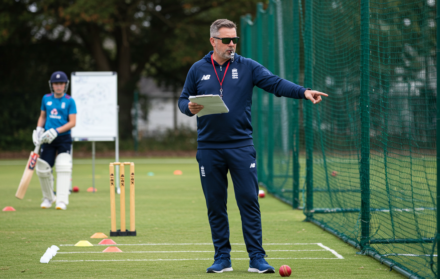
How To Train For Endurance And Stamina In Cricket Bowling
Cricket bowling requires a unique combination of physical fitness, skill, and strategy. One crucial aspect of becoming a successful bowler is developing endurance and stamina. This article will guide you on how to train effectively to enhance your endurance and stamina specifically for cricket bowling.
Firstly, it is important to understand the demands of cricket bowling and the physical requirements it entails. This includes having a strong core, lower body strength, good balance, and agility. Bowlers often face challenges in terms of maintaining their endurance and stamina throughout long matches or extended bowling spells.
The key principles of endurance and stamina training for cricket bowling involve developing a solid cardiovascular base through aerobic exercises, incorporating specific cricket bowling movements into training drills, focusing on muscular endurance through resistance training, and implementing interval training to improve stamina.
Designing a structured training program is crucial for progress. This includes setting clear goals and objectives, selecting appropriate exercises and drills that mimic bowling movements, creating a progressive training plan that gradually increases intensity and duration, and regularly monitoring and assessing progress to make necessary adjustments.
Nutrition and hydration are vital for supporting endurance and stamina. Proper nutrition provides the necessary energy for performance and aids in recovery, while hydration guidelines should be followed to maintain optimal performance levels.
Recovery and injury prevention strategies should not be overlooked. Rest and recovery are essential for muscle repair and growth. Effective warm-up and cool-down routines help prepare the body for bowling and prevent injuries. Incorporating injury prevention exercises and techniques can also help maintain physical well-being.
By following these guidelines and training strategies, you can enhance your endurance and stamina in cricket bowling, improving your performance and contributing to your team’s success.
Understanding the Demands of Cricket Bowling
.jpg)
Understanding the demands of cricket bowling is crucial for developing endurance and stamina in this sport.
In order to excel in cricket bowling, it is vital to have a deep comprehension of the requirements involved. This understanding plays a pivotal role in building the necessary physical fitness and stamina.
Bowlers need to be physically fit and possess the ability to perform repetitive actions with consistency.
Physique and consistency are pivotal for bowlers, as it is imperative that they are in peak physical condition and capable of executing repetitive motions.
Key factors to consider include the requirement for explosive power during the delivery stride, the need to generate sufficient speed, and the ability to maintain accuracy throughout a long spell.
Certain pivotal aspects must be taken into account, such as the explosive power needed during the delivery stride, the necessity to generate ample speed, and the ability to sustain accuracy throughout a prolonged period.
Successful training programs focus on building muscular strength, increasing cardiovascular fitness, and improving flexibility to meet the specific demands of cricket bowling.
Training programs that yield positive results place emphasis on enhancing muscular strength, boosting cardiovascular fitness, and enhancing overall flexibility, which are essential for meeting the unique demands of cricket bowling.
Adequate rest and recovery periods are also essential for preventing injuries and maintaining performance levels.
Moreover, sufficient rest and recovery periods are of utmost importance to prevent injuries and sustain optimal performance levels.
What are the Physical Requirements of Cricket Bowling?
The physical requirements of cricket bowling include strength, flexibility, and endurance. Bowlers require strong muscles, especially in the shoulders, core, and legs, in order to generate power and maintain stability during their delivery stride.
It is crucial to have flexibility to allow for a full range of motion and prevent injuries. Endurance is also essential as bowlers must sustain their performance levels throughout a match or a long spell of bowling. This necessitates cardiovascular fitness and muscular endurance to withstand the repetitive motions and demands of the game.
Here’s a pro-tip: Incorporate regular strength and conditioning exercises, along with cardiovascular training, to enhance your physical abilities for cricket bowling.
What are the Common Challenges Faced by Bowlers in Terms of Endurance and Stamina?
Bowlers face several challenges in terms of endurance and stamina in cricket. The physical demands of bowling, including repeated explosive movements and maintaining a consistent pace, can lead to fatigue and decreased performance.
Bowlers often struggle with maintaining their form and accuracy as they tire. To overcome these challenges, bowlers should focus on developing their cardiovascular fitness, muscular endurance, and incorporating interval training into their workouts.
Proper nutrition and hydration are also crucial for sustaining energy levels throughout a match. Implementing recovery strategies such as rest, warm-up and cool-down routines, and injury prevention exercises can help bowlers maintain their endurance and stamina in the long run.
Key Principles of Endurance and Stamina Training for Cricket Bowling
Looking to boost your endurance and stamina for cricket bowling? Get ready to dive into the key principles that will take your game to the next level. From developing a strong cardiovascular base to incorporating specific bowling movements, we’ll cover it all.
Don’t forget to focus on muscular endurance and implement interval training for maximum stamina improvement. Get ready to dominate the pitch with these expert-backed training strategies.
Developing a Solid Cardiovascular Base
Developing a solid cardiovascular base is crucial for endurance and stamina in cricket bowling. Here are the steps to achieve this:
- Incorporate aerobic exercises like running or cycling into your training routine.
- Gradually increase the duration and intensity of your cardio sessions to develop a solid cardiovascular base.
- Include interval training, alternating between high-intensity bursts and lower-intensity active recovery periods.
- Add circuit training to work on both cardiovascular fitness and muscular endurance.
- Cross-train with activities like swimming or rowing to engage different muscle groups and build a strong cardiovascular base.
- Monitor your heart rate during workouts to ensure you are working at the right intensity level for developing a solid cardiovascular base.
- Allow for adequate rest and recovery between cardio sessions to avoid overtraining and promote the development of a solid cardiovascular base.
Incorporating Specific Cricket Bowling Movements
- To effectively train for endurance and stamina in cricket bowling, it is crucial to incorporate specific cricket bowling movements into your training routine. Here are the steps to do so:
- Start with a proper warm-up to prepare your muscles and joints for the specific movements involved in bowling.
- Practice the correct bowling technique, focusing on incorporating specific cricket bowling movements, proper body alignment, arm position, and follow-through.
- Incorporate drills that simulate cricket bowling actions, such as target bowling, stump hitting, and spot bowling.
- Include exercises that strengthen the muscles used in cricket bowling, such as shoulder and core exercises to improve stability and control.
- Perform interval training sessions that mimic the demands of cricket bowling, alternating between periods of high-intensity cricket bowling action and periods of rest or lower-intensity activities.
- Regularly assess your technique and make adjustments as needed, seeking guidance from a coach or experienced player.
- Gradually increase the intensity and duration of your cricket bowling sessions over time, progressively challenging your endurance and stamina levels.
- Ensure proper rest and recovery between training sessions to allow your muscles to repair and adapt.
Focusing on Muscular Endurance
- To enhance muscular endurance in cricket bowling, players should focus on targeted exercises and training techniques. Here are some steps to consider:
- Incorporate resistance training exercises, such as squats and lunges, to build muscular strength and focus on muscular endurance.
- Perform high-intensity interval training (HIIT) to improve both cardiovascular endurance and muscular endurance.
- Include plyometric exercises, like box jumps and medicine ball throws, to develop explosive power and muscular endurance.
- Practice specific bowling movements with lighter weights to improve muscular endurance in those specific muscles.
Implementing Interval Training for Stamina Improvement
To enhance stamina in cricket bowling, the implementation of interval training can prove to be extremely effective. Interval training, which involves alternating periods of high-intensity exercise with periods of rest or low-intensity exercise, can greatly contribute to stamina improvement in cricket bowling. Here are the suggested steps for incorporating interval training:
- Begin with a warm-up routine to adequately prepare the body for the upcoming exercise session.
- Select an exercise or drill that accurately replicates the movements required in cricket bowling.
- Execute the chosen exercise at a high intensity for a specific duration, for example, 30 seconds.
- Follow the high-intensity exercise with a period of rest or low-intensity exercise, such as 60 seconds.
- Repeat these alternating high-intensity and low-intensity periods for the desired number of sets, progressively increasing the intensity and duration over time.
- Conclude the training session with a cooldown period to allow the body to properly recover.
By implementing interval training to enhance stamina, cricket bowlers can effectively develop endurance, improve cardiovascular fitness, and elevate their overall performance on the field.
Designing a Training Program for Endurance and Stamina in Cricket Bowling
Looking to up your game as a cricket bowler? Look no further! In this section, we’ll dive into the world of designing a training program specifically tailored for endurance and stamina in cricket bowling.
From setting goals and objectives to choosing the right exercises and drills, we’ll cover it all. Plus, we’ll explore the importance of creating a progressive training plan and monitoring your progress along the way. Get ready to take your cricket bowling skills to new heights!
Setting Goals and Objectives
Setting goals and objectives is essential when training for endurance and stamina in cricket bowling. Here are key points to consider:
- Identify specific performance goals, such as increasing the number of overs bowled or improving bowling speed.
- Set measurable objectives, like increasing the distance covered while running or reducing rest time between bowling sets.
- Ensure that the goals and objectives are realistic and attainable within a given timeframe.
- Take into account individual strengths and weaknesses to personalize the goals accordingly.
- Regularly monitor progress to track improvement and adjust goals if necessary.
- Seek guidance from a coach or trainer to help establish appropriate goals and objectives.
Choosing Appropriate Exercises and Drills
Choosing appropriate exercises and drills is crucial for ensuring effective training in endurance and stamina specifically for cricket bowling. It is important to keep the following key considerations in mind:
- Incorporate cricket bowling movements that are specific to the sport, including practicing different bowling variations and focusing on mastering proper technique.
- Include exercises such as lunges, squats, and planks in your training routine to target and strengthen the muscles used in bowling, thus enhancing muscular endurance.
- To improve stamina and replicate the demands of a cricket match, integrate interval training into your regimen. This involves alternating between periods of high-intensity bursts of activity and intervals of rest.
- Develop a solid cardiovascular foundation by incorporating cardiovascular exercises such as running, cycling, or swimming into your training routine.
- Enhance your overall athleticism and quick reaction times by incorporating agility drills like ladder drills or cone drills into your training program. This will add variety to your workouts and improve your agility.
Creating a Progressive Training Plan
Creating a progressive training plan is crucial for building endurance and stamina in cricket bowling. Here is a list of steps to follow:
- Assess current fitness levels and identify areas for improvement.
- Set specific and measurable goals for endurance and stamina.
- Select exercises and drills that target cardiovascular fitness, strength, and bowling-specific movements.
- Start with lower intensity and gradually increase the duration and intensity of training sessions.
- Incorporate interval training to improve stamina and simulate match conditions.
- Periodically assess progress and adjust the training plan accordingly.
By incorporating a progressive training plan, cricketers can develop the physical capabilities required for long bowling spells in matches.
Monitoring and Assessing Progress
Monitoring and assessing progress is fundamental for effective endurance and stamina training in cricket bowling. To ensure optimal progress, follow the steps below:
- Regularly track performance metrics, such as bowling speed, accuracy, and endurance levels.
- Maintain a training journal to document your workouts, including repetitions, sets, and rest periods.
- Periodically evaluate your fitness levels using benchmark tests, such as the Yo-Yo Intermittent Recovery Test.
- Analyze the gathered data to identify areas for improvement and monitor progress over time.
- Modify your training plan based on the results to enhance performance and address specific weaknesses.
Pro-tip: Consider utilizing technology like wearable fitness trackers or video analysis to obtain more precise and detailed feedback on your performance.
Nutrition and Hydration for Endurance and Stamina in Cricket Bowling
Proper nutrition and hydration play a pivotal role in enhancing endurance and stamina in cricket bowling. Learn how to fuel your body to boost energy levels and promote efficient recovery. Discover the hydration guidelines that can help you maintain optimal performance on the field. Get ready to unlock your full potential as we delve into the importance of nutrition and hydration in improving your cricket bowling game.
The Role of Proper Nutrition for Energy and Recovery
Proper nutrition plays a crucial role in providing energy and promoting recovery for cricket bowlers. The role of proper nutrition for energy and recovery cannot be overstated. A well-balanced diet that includes carbohydrates, proteins, and fats is essential to fuel the body and support muscle repair.
By incorporating the role of proper nutrition for energy and recovery, cricket bowlers can enhance their endurance and stamina on the field. Carbohydrates, which provide a readily available source of energy, must be included in the diet.
Similarly, proteins play a vital role in muscle recovery and growth. To meet their nutritional needs, cricket bowlers must include fruits, vegetables, whole grains, lean meats, and healthy fats in their diet. In addition to these dietary considerations, adequate hydration is also vital for optimal performance and recovery.
Maintaining proper fluid balance and preventing fatigue can be achieved by hydrating before, during, and after training sessions or matches. Therefore, it is crucial for cricket bowlers to prioritize proper nutrition and understand the role of proper nutrition for energy and recovery for their overall performance.
Hydration Guidelines for Optimal Performance
To maintain optimal performance in cricket bowling, it’s essential to follow the hydration guidelines for optimal performance. Staying properly hydrated helps prevent fatigue, muscle cramps, and decreased concentration during matches. Here are some suggestions to ensure proper hydration:
- Drink water consistently throughout the day, not just during matches or training sessions.
- Monitor urine color: pale yellow indicates adequate hydration, while dark yellow suggests dehydration.
- Consume electrolyte-rich beverages to replenish minerals lost through sweat.
- Avoid sugary drinks or excessive caffeine, as they can dehydrate the body.
- Develop a personalized hydration plan based on the duration and intensity of training or matches.
By following these hydration guidelines for optimal performance, cricketers can enhance endurance and stamina on the field.
Recovery and Injury Prevention Strategies
Discover the key strategies for recovery and injury prevention in cricket bowling. From the crucial importance of rest and recovery to effective warm-up and cool-down routines, and injury prevention exercises and techniques, we’ll delve into the essential elements that can help you maintain your endurance and stamina on the cricket pitch. So, let’s explore these game-changing strategies that will keep you in top form and prevent any setbacks on your cricketing journey.
The Importance of Rest and Recovery
Rest and recovery are of utmost importance for training in endurance and stamina in cricket bowling. Acknowledging the significance of giving your body enough time to recover is essential for muscle repair and growth.
Rest not only aids in preventing overuse injuries and fatigue but also allows for proper healing. Implementing effective recovery strategies involves prioritizing sufficient sleep, maintaining a well-balanced diet, and engaging in low-intensity activities during rest periods.
To further enhance recovery, it is recommended to incorporate regular rest days and include restorative practices such as stretching and foam rolling. By valuing the role of rest and recovery, cricketers can optimize their performance while minimizing the risk of burnout or injury.
Effective Warm-Up and Cool-Down Routines
- A well-designed warm-up and cool-down routine is crucial for cricket bowlers to prevent injuries and maximize performance.
- Dynamic Stretching: Incorporate dynamic stretches like leg swings and arm circles into your warm-up to improve flexibility and increase your range of motion.
- Cardiovascular Exercise: Prioritize light aerobic exercises such as jogging or skipping during your warm-up to enhance blood flow and elevate your body temperature.
- Sport-Specific Movements: Include cricket-specific movements like shadow bowling or using lighter balls in your warm-up to replicate the demands of the sport.
- Gradual Intensity Build-up: Begin with low-intensity exercises and progressively increase the intensity to properly prepare your body for the upcoming challenges.
- Cool-Down Exercises: After bowling, incorporate static stretches into your cool-down to elongate the muscles and diminish post-exercise soreness.
- Self-Massage: Utilize foam rollers or massage balls to relieve muscle tension and enhance recovery after the session.
- Hydration: Remember to drink ample water before, during, and after the session to maintain proper hydration levels.
Injury Prevention Exercises and Techniques
To prevent injuries in cricket bowling, it is vital to include Injury prevention exercises and techniques into training routines. Here are some important steps to consider:
- Dynamic warm-up: Begin each session with dynamic stretching and mobility exercises to prepare the body for movement.
- Strengthening exercises: Focus on strengthening the muscles involved in bowling, such as the shoulder, forearm, and core muscles.
- Bowling technique refinement: Work on refining bowling technique to ensure proper alignment, reducing the risk of strain or injury.
- Cross-training: Engage in activities like swimming or cycling to improve overall fitness and reduce overuse injuries.
- Rest and recovery: Allow adequate rest between training sessions to allow the body to recover and prevent overuse injuries.
Remember to listen to your body and seek professional guidance if experiencing pain or discomfort. Incorporating these Injury Prevention Exercises and Techniques into your training routine can help keep you on the pitch and performing at your best.





